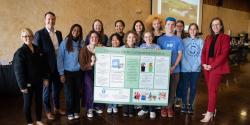Cumberland, OH – The Wilds welcomed a female southern white rhinoceros calf born in the pasture during the afternoon of October 23, 2019. The calf is the 21st white rhino to be born at The Wilds since 2004 and the third fifth-generation white rhino to be born at the conservation facility—the only facility that has had fourth and fifth generation births of the species outside of Africa.
The rhino has been named “Scout” as recognition for the generosity of Iron Pony Motorsports and their four consecutive years of dollars raised from their annual “Ride For Rhinos” motorcycle ride. Considered one of the largest motorcycle rides to benefit protected wildlife species in the world, more than 600 participants rode from Westerville, Ohio to The Wilds in Cumberland, Ohio this year. President and CEO Chris Jones was inspired by the name “Scout,” a brand of motorcycle, and an appropriate name for a curious calf whose arrival is helping to secure the future of rhinos.
Scout and her 5-year-old mother, Agnes, who was also born at The Wilds, are doing well and continue to bond. The Wilds’ Animal Management team members note that while Agnes is a first-time mother, Scout appears to be strong and is nursing alongside her attentive mother. The pairing of Agnes and 21-year-old Kengele, who was born at the San Diego Zoo Safari Park and is a first-time father, was recommended through the Association of Zoos and Aquariums’ (AZA) Species Survival Plan® (SSP). This program is designed to maintain a sustainable population and genetic diversity of threatened and endangered species in human care. The Wilds has also welcomed the births of eight Asian one-horned rhinos since 2005. The most recent Asian one-horned rhino calf, a female named Rohini, was welcomed into The Wilds’ family on August 24, 2019.
“We are thrilled to announce the arrival of this white rhinoceros calf and to continue to be part of the species’ conservation story,” said Dr. Jan Ramer, vice president of The Wilds. “We are very proud of our contributions to working to protect the future of rhinos, and this birth is a true testament to the success of our program.”
The white rhino population had dwindled to perhaps only 50-200 individuals at the beginning of the 20th century, but through conservation efforts, the population of white rhinos in their native African range has rebounded to about 20,400 animals. However, even with the increase in numbers, the species remains classified as near threatened by the International Union for Conservation of Nature (IUCN). All five remaining rhino species in Africa and Asia (white rhinoceros, black rhinoceros, greater one-horned rhinoceros, Javan rhinoceros, and Sumatran rhinoceros) are persecuted by poachers who sell rhino horn for ornamental or traditional medicinal purposes even though there are no scientifically proven health benefits for its use. The horns are made of keratin—the same substance that makes up fingernails and hair. The International Rhino Foundation, which receives support from The Wilds, estimates that one rhino is killed every 10 hours for its horn.
White rhino calves are born after a gestation of 16 months and they can grow to be 4,000 pounds and six feet tall at their shoulder. Their habitats typically consist of plains or woodlands, interspersed with grassy openings. Through reintroduction efforts, their native range has been established in southern and eastern African countries.
Their physical characteristics are two pointed horns and a wide mouth suitable for grazing. The name white rhinoceros originated from the Afrikaans word describing the animal’s mouth – wyd, meaning “wide.” Early English settlers in South Africa misinterpreted the word wyd for “white.”
To further protect the future of rhinos, The Wilds and the Columbus Zoo has provided more than $222,000 in the last five years in support of conservation projects benefiting rhinos in their native ranges, such as monitoring black and white rhinos in Zimbabwe’s Lowveld region through the International Rhino Foundation, protecting black rhinos in the Ngulia Rhino Sanctuary in Kenya through the African Wildlife Foundation and habitat restoration focused on the shortgrass that white rhinos eat through the White Rhinos: Rhinoceros Fund Uganda.
Guests may have the opportunity to view the calf and her mother in the rhino barn during a Winter at The Wilds tour beginning November 1, 2019. Tours are available at 11 a.m. and 2 p.m. through April. Reservations must be made at least 72 hours in advance. For more information, visit TheWilds.org.
###
About The Wilds
The Wilds, one of the largest conservation centers in North America, is home to rare and endangered animals from around the world along with hundreds of indigenous species. The mission of The Wilds, a nonprofit organization managed by the Columbus Zoo and Aquarium, is to lead and inspire by connecting people and wildlife. The Wilds is located at 14000 International Road in Cumberland, Ohio, about 90 minutes east of Columbus. Normal hours of operation are 10 a.m. to 4 p.m. every day from May through September, and on Saturdays and Sundays in October. For more information, visit TheWilds.org.









